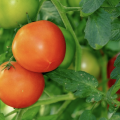Some of the leaves on my plants are turning yellow. What is causing this?
Yellowing leaves can be caused by several situations. The following are the most common:
1) Early Blight (fungus) - If this is the cause, you should see small circular brown lesions on the leaves as well. The spots become larger. Eventually, bottom leaves fall off.
2) Shading - As the plants mature, the bottom leaves get heavily shaded and naturally turn yellow as they senesce (age). This is not a problem. Any yellowing leaves are no longer productive and should be removed to improve air circulation.
3) Low nitrogen or potassium - If the nitrogen or potassium level is too low, yellowing will occur. Nitrogen deficiency shows up as a general yellowing of the entire plant. Potassium deficiency will appear as bright yellow leaf margins (edges) on otherwise green leaves.
4) Low Magnesium - Interveinal yellowing on older leaves is from low magnesium. If this is suspected, spray 2 TBL per gallon of magnesium sulfate (epsom salt) on the plants and see if they "green up" in a few days. For all suspected nutrient problems, a tissue analysis is recommended.
Publications
News
RAYMOND, Miss. -- Current and prospective greenhouse vegetable growers can learn about the specialized production method during Mississippi State University’s 2024 Greenhouse Vegetable Short Course on Feb. 27-28. The course will be held at the North Mississippi Research and Extension Center’s Magnolia Building in Verona from 8 a.m. to 5 p.m. each day. It is open to greenhouse vegetable producers throughout the Southeast.
STARKVILLE, Miss. -- Vegetable growers soon will have two chances to learn about managing pests on produce in greenhouses and high tunnels.
There’s nothing more satisfying than homegrown tomatoes. You don’t have to be a gardening expert to grow delicious tomatoes in your backyard. Here are a few tips that will help you grow the best looking (and tasting) tomatoes out there:



